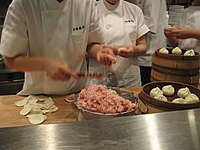Xiaolongbao
 Steamed xiaolongbao served in a traditional steaming basket | |
| Alternative names | xiao long bao, xiaolong mantou, XLB |
|---|---|
| Course | Breakfast, xiaochi |
| Place of origin | Changzhou, Jiangsu, China |
| Main ingredients | Leavened or unleavened dough, minced pork (or other meats) |
| Chinese name | |
|---|---|
Hanyu Pinyin | xiǎolóng mántou |
| Bopomofo | ㄒㄧㄠˇ ㄌㄨㄥˊ ㄇㄢˊ ㄊㄡ˙ |
| Gwoyeu Romatzyh | sheaulong mantou |
| Wade–Giles | hsiao3-lung2 man2-t‘ou |
| Tongyong Pinyin | siǎo-lóng mán-tȯu |
| IPA | [ɕjàʊ.lʊ̌ŋ mǎn.tʰoʊ] |
| Wu | |
| Shanghainese Romanization |
|
| Yue: Cantonese | |
| Jyutping |
|
| IPA | |
| Transcriptions | |
|---|---|
| Revised Romanization | syaolungbao |
| Transcriptions | |
|---|---|
| Revised Hepburn | shōronpō |
| Kunrei-shiki | syouronpou |
Xiaolongbao (.
In some parts of China and overseas, xiao long bao may specifically refer to a kind of soup dumpling, the
Origins
"Xiaolongbao" originated in
Ingredients
Chinese buns, in general, may be divided into two types, depending on the degree of
Xiaolongbao are traditionally filled with pork.[1] More modern innovations include other meats, seafood, shrimp, crab meat, and vegetarian fillings.
Soup dumplings are created by wrapping solid meat aspic inside the skin alongside the meat filling. Heat from steaming then melts the gelatin-gelled aspic into soup. In modern times, refrigeration has made the process of making tangbao during hot weather easier, since making gelled aspic is much more difficult at room temperature.
Serving
Xiaolongbao are traditionally eaten for breakfast. The buns are served hot in the bamboo baskets in which they were steamed, usually on a bed of dried leaves or paper mat, although some restaurants now use napa cabbage instead. The buns are usually dipped in Zhenjiang vinegar with chili crisp.
Traditionally, tangbao soup dumplings are a kind of
-
Making xiaolongbao at Nanxiang Mantou Dian, Roppongi Hills
-
The perennial queue outside theNanxiang Bun Shopin Shanghai
Types
Changzhou
The modern form of Xiaolongbao originated from Qing Dynasty. A place named YingGui Teahouse is where people in ChangZhou go to have Xiaolongbao. Xiaolongbao in Changzhou is known for its thin wraps, great taste of its ingredients, and the soup that spills out when taken a bite. Among the types, crab filled Xiaolongbao is the most well known type in Changzhou that are served after the mid autumn festival.[9][unreliable source?]
Shanghai
Nanxiang Xiaolongbao in Shanghai have around a hundred year of history. They are known for their unique technique of making the wrappers as well as secret ingredients of the fillings.[10]
Tianjin
Goubuli Xiaolongbao is the most famous Xiaolongbao in the northern China. Goubuli is founded in 1858 by a young man named Gouzi, who named his xiaolongbao after himself as Goubuli later. Goubuli Xiaolongbao has strictly 18 wrinkles on each dumpling due to its creator's unique method of making it. Goubuli Xiaolongbao were served to one of the famous queen's mother in Chinese history as a famous dish from Tianjin.[11]
Kaifeng
Kaifeng Xiaolongbao, created in Song Dynasty, is also known as soup filled Xiaolongbao. Many famous cooks created their own ways of making soup filled dumplings in Kaifeng and improved the techniques throughout history. Kaifeng Xiaolongbao looks like "a lantern" when you lift the dumpling and "a flower" when it sits in the steaming basket.[12]
See also
- Baozi
- Din Tai Fung
- Dumpling
- Jiaozi
- Khinkali
- List of steamed foods
- List of buns
- Momo (food)
- Shanghainese cuisine
- Shengjian mantou
- Siopao
- Salteña, another dumpling with a gelatin-based liquid filling
Explanatory notes
- ^ the West refers to the Western world
Citations
- ^ ISBN 978-1-74360-581-3. Retrieved November 5, 2016.
- ^ In ancient times, stuffing in the dough was called steamed buns. See Zeng Weihua, "Ancient Mantou", "Journal of Shanghai Normal University (Philosophy and Social Sciences Edition)" No. 2, 1995, p. 157
- ^ "Dumplings, a dish on the to-do list". SHINE. Retrieved 2020-01-27.
- ^ "Food Wars: Xiaolongbao Edition". GOOD. 2016-11-17. Retrieved 2020-01-27.
- ^ china.org.cn. July 18, 2012. Retrieved 10 February 2013.
- ^ "[How to]: Eat Xiaolongbao Like a Scientist | SmartShanghai". www.smartshanghai.com. Retrieved 2020-01-27.
- ^ "Shanghai's 7 Essential Soup Dumplings: Xiaolongbao". Xtreme Foodies - The world's Essential Eats curated by local food experts. 2015-07-09. Retrieved 2020-01-27.
- ^ From the Annals of Jiading (a district in Shanghai)
- ^ "小籠包:歷史文化,各地版本,常州小籠包,無錫小籠包,上海小籠包,天津小籠包,開封小_中文百科全書". www.newton.com.tw. Retrieved 2022-11-23.
- ^ Mike. "南翔小笼包". nanxiangxiaolongbao. Retrieved 2022-11-23.
- ^ "狗不理包子". www.tjdag.gov.cn. Retrieved 2022-11-24.
- ^ 郑州食尚香 (2016-11-01). "开封小笼包是怎么来的?小笼包的特色吃法你知道吗?-食尚香郑州小吃培训学校". m.ssxmyxc.com (in Chinese (China)). Retrieved 2022-11-24.


